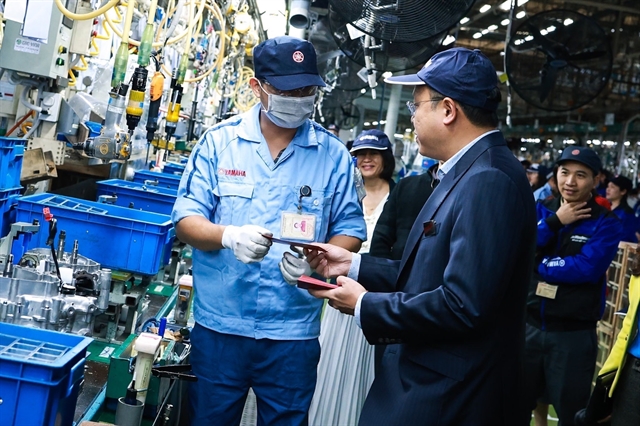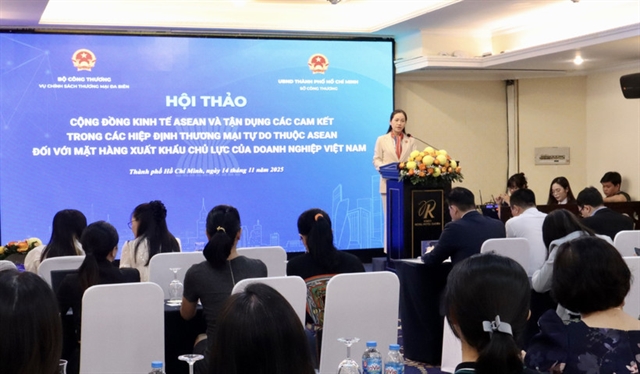 Society
Society

 |
| About 90-100 per cent of labourers in Bắc Giang Province come back to work after Tết holiday. — VNA/VNS Photo Đồng Thúy |
HÀ NỘI — The post-Tết (Lunar New Year) labour market is predicted to witness many significant changes, with opportunities and challenges intertwined for both businesses and employees, according to experts.
This is an important time for both sides to grasp trends and develop appropriate strategies to maximise potentials.
After the Lunar New Year, workers frequently wish to switch workplaces and search for better employment possibilities, according to experts.
In order to make up for the shortages caused by resignations or job changes in the last months of the year, businesses typically hire extra employees. For job seekers, particularly those with specialised talents or experience, the labour market is now opening up a wide range of choices.
Surveys conducted by human resource organisations indicate that jobs like technology technicians, salespeople and manual labourers will be the most in-demand, the Voice of Vietnam (VOV) reported.
This comes from the demand to expand the business scale of enterprises and the digital transformation that is taking place strongly in many places.
It is anticipated that the technology, renewable energy and logistics sectors would continue to expand rapidly in 2025.
Vũ Quang Thành, deputy director of the Hà Nội Employment Service Centre, said at the end of 2024 and the beginning of 2025, the recruitment demand in the capital market is quite vibrant. Businesses operating in express delivery services, restaurant – hotel business, trade – production are in need of recruiting a lot of workers to serve the peak demand at the Lunar New Year holiday and in the first months of the new year.
The Ministry of Labour, Invalids and Social Affairs assessed that there will be a labour shortage in important areas, where many industrial parks and export processing zones are concentrated.
Some big businesses had extra orders to fulfil for the year-end holidays, but they neglected to prepare for the human resource, which resulted in a scarcity of employees, primarily unskilled workers in the electronics assembly and textile and apparel industries.
 |
| Chairman of Hà Nội Labour Federation Phạm Quang Thanh gives lucky money to a labourer at the city's Industrial and Export Processing Zone on the first working day of the Lunar New Year. — VNA/VNS Photo |
Associate Professor Đinh Trọng Thịnh, from the Academy of Finance, said the labour market has shown positivity at the beginning of this year with many businesses attracting a large number of workers and the expansion of production activities.
“The labour market’s development remains complicated and will face many challenges. Due to the State apparatus streamlining policy, a large number of public sector employees will have to look for jobs. This is not an easy task, especially for the elderly workforce,” he told VOV.
He believes the export of goods is experiencing some challenges, which would have a big impact on the labour market.
"Hopefully, businesses will see an improvement in orders in February and March, which will lead to a stable labour market," he added.
In 2025, the issue of labour supply and demand is somewhat complex. The supply is increasing significantly, which is one of the important factors that makes the labour market more flexible and competitive.
If production and business continue to be strongly expanded, the labour supply will be matched by the market demand, he said.
But if the production and business expansion remains at a moderate level, the labour force will be excessive and it will be more challenging for workers to find jobs, he said.
Nguyễn Thị Thanh Mai, deputy director of the Population and Labour Statistics Department under the General Statistics Office, said although the labour market is still recovering, there are still many issues with the quality of the labour supply, which prevents it from meeting the demands of a contemporary, flexible, sustainable and interconnected labour market.
She cited that the country still has 71.4 per cent of untrained workers with no certificates. Employed workers tend to increase, but the labour market is not developing sustainably when the number of informal workers doing unstable jobs still accounts for a large proportion, about more than three fifths of the total number of employed workers in the country.
According to experts, the labour market will have to deal with numerous significant changes in working forms, recruitment needs, and skill requirements as a result of the rapid advancement of technology and digital transformation.
In order to adapt, workers must enhance their knowledge and abilities and get ready for change. To keep talent and encourage long-term success, businesses must also concentrate on creating an appealing workplace.
Solutions
The Ministry of Labour, Invalids and Social Affairs (MOLISA) said various measures have been adopted by both authorities and enterprises to ensure stability for the labour market and prevent manpower shortages in key economic regions after the Lunar New Year holiday.
Speaking at the Government’s regular press conference on Wednesday, MOLISA Deputy Minister Nguyễn Văn Hồi said more than 52 million people are participating in the labour market, playing an extremely important role in sustaining production and business activities of enterprises and the whole economy.
Previously, part of the workforce often extended their leave, switched jobs or changed living places after Tết, leading to labour shortages at certain factories and in some localities.
Facing that fact, before this year’s Tết, the ministry had instructed localities to gain a good grasp of the labour market as well as the specific situation of local plants and enterprises to take comprehensive measures for ensuring market stability, he noted.
He elaborated that provinces and cities have effectively carried out the labour market development plan under the Prime Minister’s Decision No.176/QĐ-TTg, issued in 2021, helping update workers and enterprises about the labour market, connect labour supply and demand, and keep the market stable before, during, and after Tết.
The ministry urged localities and enterprises to properly implement salary and bonus policies for employees, especially those in industrial and export processing zones. They were also encouraged to arrange coaches to carry workers home for Tết and back to factories after the holiday while giving bonuses to those returning to work on time.
So far, industrial and export processing zones in such big industrial hubs as Hà Nội, Bắc Giang, Bắc Ninh, and Thái Nguyên in the North, as well as HCM City, Long An, Đồng Nai, and Bình Dương in the South have seen the majority of workers returning. Many has recorded the rate of labourers back to work at 97-98 per cent, and even 100 per cent, he said.
Many companies and industrial parks gave financial support covering workers’ Tết travel costs and provided a 13th-month salary.
Job fairs have also been held after Tết in many provinces and cities to connect stakeholders in the labour market, he said. — VNS




